At the outbreak of the war, Joseph Totten was a General and Chief of the United States Engineers
These dispatches were compiled with primary source materials from The War of the Rebellion: A Compilation of Official Records of the Union and Confederate Armies (Chapter 1)
|
CONTENTS
This feature is not yet available. Check back soon for updates!
(US Capt) John Foster
- At the outbreak of the war, John Foster was a Captain of Engineers in the United States Corps of Engineers
| To Totten:
|
From Totten:
|
| January 9, 1861 - Captain John Foster to Colonel Joseph Totten
|
 Click for full-sized scanned image Union Correspondence, etc.
FORT SUMTER, S.C., January 9, 1861.
General TOTTEN;
MY DEAR SIR: I have only a moment to write by Lieutenant Meade [?], who comes with dispatches from Major Anderson. I wish to assure you, however, that the officers of your corps are doing everything in their power to make this work impregnable, even with the present small garrison of seventy men. We even mount all the guns, as we can do it much more rapidly than the garrison. We have twenty-nine guns on the first tier and eleven on the barbette tier. Four 8-inch columbiads are ready to mount to-morrow. I shall place the 10-inch on the parade as mortars.
The firing upon the Star of the West this morning by the batteries on Morris Island opened the war, but Major Anderson hopes that the delay of sending to Washington may possibly prevent civil war. The hope, although a small one, may be the thread that prevents the sundering of the Union. We are none the less determined to defend ourselves to the last extremity. I am in want of funds,and would respectfully urge that as soon as possible $15,000 may be placed to my credit in New York. In haste.
Very respectfully,
J.G. FOSTER,
Captain, Engineers.
P.S. - I beg to refer you to Lieutenant Meade [?] for particulars.
J.G.F.
[Memorandum.]
Received January 12 by Lieutenant Talbot, U.S. Army.
(To view this page in its Source Category, click HERE)
|
|
|
| January 12, 1861 - Captain John Foster to Colonel Joseph Totten
|
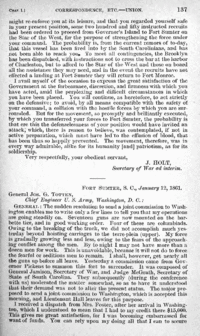 Click for full-sized scanned image 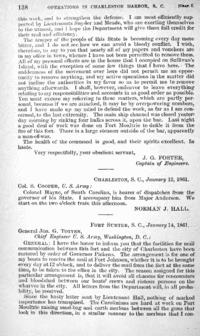 Click for full-sized scanned image Union Correspondence, etc.
FORT SUMTER, S.C., January 12, 1861
General JOS. G. TOTTEN,
Chief Engineer U.S. Army, Washington, D.C.:
GENERAL: The sudden resolution to send a joint commission to Washington enables me to write only a few lines to tell you that my operations are going steadily on. Seventeen guns are now mounted on the barbette tier, and in good working order. Four of these are columbiads. Owing to the breaking of the truck, we did not accomplish much yesterday beyond hoisting carriages to the terre-plain (upper). My force is gradually growing less and less,owing to the fears of the approaching conflict among the men. By to night I may not have more than a dozen men for work. This is unavoidable, because it will not do to force the fearful or seditious men to remain. I shall, however, get nearly all the guns up before all leave. Yesterday a commission came from Governor Pickens to summon this fort to surrender. It was composed of General Jamison, Secretary of War, and Judge McGrath, Secretary of State of South Carolina. They subsequently (during the conference with us) moderated the matter somewhat, so as to have it understood that their demand was not to alter the present status. The major proposed to send a joint commission to Washington, which is accepted this morning, and Lieutenant Hall leaves for this purpose.
I received a dispatch, from Mrs. Foster, after her arrival in Washington, which I understood to means that I had to my credit there $15,000. This gives me great satisfaction, for I was becoming embarrassed for want of funds. You can rely upon my doing all that I can to secure this work, and to strengthen the defense. I am most efficiently supported, by Lieutenants Snyder and Meade, who are exerting themselves to the utmost, and I hope the Department will give them full credit for their zeal and efficiency.
The temper of the people of this State is becoming every day more bitter, and I do not see how we can avoid a bloody conflict. I wish, therefore, to say to you that nearly all of my papers and vouchers are in my office in town, whence I have not been permitted to remove them. All of my personal effects are in the house that I occupied on Sullivan's Island, with the exception of some few things that I have here. The suddenness of the movement over here did not permit me an opportunity to remove anything, and my active operations in the matter did not incline the authorities in my favor so as to permit me to remove anything afterwards. I shall, however, endeavor to leave everything relating to my responsibilities and accounts in as good order as possible. You must excuse my referring to these matters, which are partly personal, because if we are attacked, it may be by overpowering numbers, and I have made up my mind to defend the work, as far as I am concerned, to the last extremity. The main ship channel was closed yesterday morning by sinking four hulks across, it upon the bar. Last night a good deal of work was done on Fort Moultrie to defile it from the fire of this fort. There is a large steamer outside of the bar, apparently a man-of-war.
The health of the command is good, and their spirits excellent. In haste.
Very respectfully, your obedient servant,
J.G. FOSTER,
Captain of Engineers.
(To view this page in its Source Category, click HERE for Part 1 and HERE for Part 2)
|
|
|
| January 14, 1861 - Captain John Foster to General Joseph Totten
|
 Click for full-sized scanned image  Click for full-sized scanned image Union Correspondence, etc.
FORT SUMTER, S.C., January 14, 1861
General JOS. G. TOTTEN,
Chief Engineer U.S. Army, Washington, D. C.:
GENERAL: I have the honor to inform you that the facilities for mail communication between this fort and the city of Charleston have been restored by order of Governor Pickens. The arrangement is for one of my boats to receive the mail at Fort Johnson, wither it is to be brought every day at 12 o'clock, and to deliver the mail from the fort at the same time to be taken to the office in the city. The reason assigned for this particular arrangement is that it will avoid all chances for rencounters and bloodshed between our boats' crews and riotous persons on the wharves in the city. All letters from the Department will, in all probability, be received.
Since the hasty letter sent by Lieutenant Hall, nothing of marked importance has transpired. The Carolinians are hard at work on Fort Moultrie raising sand-bag and earth merlous between all the guns that look in this direction, in a similar manner to the merlous that I constructed on the front facing the sand hills. The force on the island is about 700 men, as I saw them drilling this evening in about that number.
I think that they have transferred several of the guns from Fort Moultrie and Castle Pinckney to the batteries on Morris Island, with the object of strengthening them, since they have found by the firing on the Star of the West that they are well placed. There is another battery on the upper end of Sullivan's Island, out of the reach of our guns, to guard the Maffitt Channel. The main ship channel is so much obstructed by the four hulks that they sunk in it on the 11th that vessels find the greatest difficulty in getting out or in, even with the harbor pilots, who can be used with safety by vessels that wish to run the gauntlet with re-enforcements for us. I do not, however, consider it good policy to send re-enforcements here at this time. We can hold our own as long as it is necessary to do so. If any force is sent here it must have the strength and facilities for landing and carrying the batteries on Morris or Sullivan's Island. The former will be the easier operation. But if the whole South is to secede from the Union, a conflict here and a civil war can only be avoided by giving up this fort sooner or later. We are, however, all prepared to go all lengths in its defense if the Government requires it. We have now, besides the twenty-nine guns mounted in the first tier (three 8-inch howitzers, five 42-pounders, and twenty-one 32-pounders), nineteen guns mounted on the third or barbette tier (six 8-inch columbiads, five 8-inch sea-coast howitzers, two 42-pounders, and six 24-pounders). These are all well placed for firing on Fort Moultrie, Morris Island, and Fort Johnson. As fast as the remaining guns are mounted they will the same object. Every precaution has been taken to secure the shutters for the embrasures and loop-holes and the main gates. The latter have been re-enforced by a solid wall three feet thick by five feet high with a narrow doorway of 20-inch width to serve for passage, and also for embrasure of an 8-inch howitzer in case of attack. A discharge of canister from this gun will sweep the wharf. The lanyard of this gun is carried back through a hole in the second gate. The lanyards of the two guns to sweep the landing to the right and left are also brought inside, to insure those guns being fired, even if the retiring guard forgets to do it while upon the outside. A large number of shells have been arranged with friction tubes to be used with long lanyards, so that the shell, being rolled over or suffered to fall from the edge of the parapet, will explode as it gets to the end of the line. The room over the gateway has also been supplied with hand grenades.
The weather since the command has occupied the fort has been very bad, and the whole force including the camp followers, have been suffered to quarter in the officer's quarters. This, together with the firing of the guns at the gateway without raising the windows, by which most of the glass on the gorge and many of the sashes were broken, has caused considerable damage to the quarters. I regard it, however, as of small moment in comparison with the necessity for keeping the command well housed and also as well warmed as the small stock of fuel will allow. The damage to the windows has been repaired temporarily. I have regarded any expense not strictly required for the defense as unnecessary under the present aspect of affairs.
During the continuance of the present arrangements for the mail I will keep you fully informed of everything that transpires.
Very respectfully, your obedient servant,
J.G. FOSTER,
Captain, Engineers.
(To view this page in its Source Category, click HERE for Part 1 and HERE for Part 2)
|
|
|
| January 21, 1861 - Captain John Foster to General Joseph Totten
|
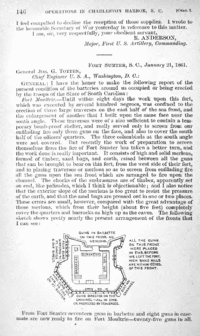 Click for full-sized scanned image 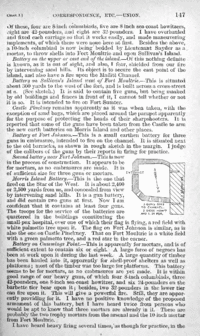 Click for full-sized scanned image  Click for full-sized scanned image Union Correspondence, etc.
FORT SUMTER, S.C., January 21, 1861.
General JOS. G. TOTTEN,
Chief Engineer U.S.A., Washington, D.C.;
GENERAL: I have the honor to make the following report of the present condition of the batteries around us occupied or being erected by the troops of the State of South Carolina;
Fort Moultrie.- Until within eight days the work upon this fort, which was executed by several hundred negroes, was confined to the erection of three large traverses on the east half of the sea front, and the enlargement of another that I built upon the same face near the south angle. These traverses were of a size sufficient to contain a temporary bomb-proof shelter, and really served only to screen from our enfilading fire only three guns on the face, and also to cover the south half of the officers' quarters. The three columbiads at the south angle were not covered. But recently the work of preparation to screen themselves from the fire of Fort Sumter has taken a better turn, and the work done is really important. It consists of high and solid merlons, formed of timber, sand bags, and earth, raised between all the guns that can be brought to bear on this fort, from the west side of their fort, and in placing traverses or merlons so as to screen from enfilanding fire all the guns upon the sea front which are arranged to fire upon the channel. The checks of the embrasures are of timber, apparently set on end, like palisades, which I think is objectionable; and I also notice that the exterior slope of the merlous is too great to resist the pressure of the earth, and that the sand bags are pressed out in one or two places. These errors are small, however, compared with the great advantage of these merlons, which from their height (about five feet) completely cover the quarters and barracks as high up as the eaves. The following sketch shows pretty nearly the present arrangement of the fronts that I can see:

From Fort Sumter seventeen guns in barbette and eight guns in casemate are now ready to fire on Fort Moultrie-twenty-five guns in all.
Of these, four are 8-inch columbiads, five are 8-inch sea-coast howitzers, eight are 42-pounders, and eight are 32-pounders. I have overhauled and fixed each carriage so that it works easily, and made maneuvering implements of which there were none here at first. Besides the above, a 10-inch columbiad is now being bedded by Lieutenant Snyder as a mortar, to throw shells into Fort Moultrie and upon Sullivan's Island.
Battery on the upper or east end of the island.- Of this nothing definite is known, as it is out of sight, and also, I fear, shielded from our fire by intervening sand hills. Its object is to secure the east point of the island, and also have a fire upon the Maffitt Channel.
Battery on Sullivan's Island west of Fort Moultrie.- This is situated about 300 yards to the west of the fort, and is built across a cross-street at a.(See sketch.) It is said to contain five guns, but being masked by old buildings and fences in front of it, I cannot tell whether or not it is so. It is intended to fire on Fort Sumter.
Castle Pinckney remains apparently as it was when taken, with the exception of sand bags, which are placed around the parapet apparently for the purpose of protecting the heads of their sharpshooters. It is reported that some of the guns have been taken from the Castle to arm the new earth batteries on Morris Island and other places.
Battery at Fort Johnson. - This is a small earthen battery for three guns in embrasure, intended to fire on the channel. It is situated next to the old barracks, as shown in rough sketch in the margin. I judge of the calibers of the guns by their reports in firing for practice.
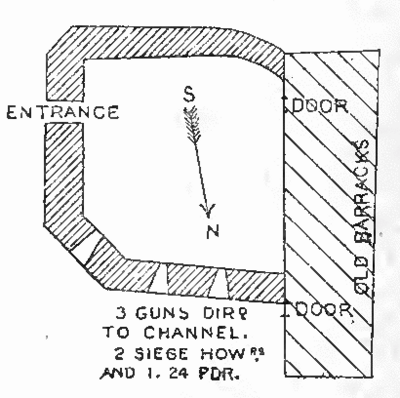
Second battery near Fort Johnson. - This is now in the process of construction. It appears to be for mortars, as no embrasures are made. It is of sufficient size for three guns or mortars.
Morris Island Battery. - This is the one that fired on the Star of the West. It is about 2,400 or 2,500 yards from us and concealed from view by intervening sand hills. It is a gun battery,and did contain two guns at first. Now I am confident that it contains at least four guns. The troops or the service of the batteries are quartered in the buildings constituting the small-pox hospital over on of which their flag is flying, a red field with white palmetto tree upon it. The flag on Fort Johnson is similar, as is also to one on Castle Pinckney. That on Fort Moultrie is a white field with a green palmetto tree, and a red star in the corner.
Battery on Cummings Point. - This is apparently for mortars, and is of sufficient extent to contain six or eight. A large force of negroes has been at work upon it during the last work. A large quantity of timber has been hauled into it, apparently for shell-proof shelters as well as platforms; most of the timber was too larger for platforms. This battery seems to be for mortars, as no embrasures are yet made. It is within good range of our heavy guns, of which four 8-inch columbiads, three 42-pounder one 8-inch sea-coast howitzer and six 24-pounders on the barbette tier bear upon it; besides, two 32-pounders in the lower tier can fire upon it. This will give a powerful fire. Still, they are apparently providing for it. I have no positive knowledge of the proposed armament of this battery, but I have heard twice from persons who would be apt to know that three mortars are already in it. These are probably the two trophy mortars from the arsenal and the 10-inch mortar from Fort Moultrie.
I have heard heavy firing several times, as though for practice, in the direction of the Stono River, and I presume a small battery has been erected there to guard that approach to the city.
Of the garrison of Castle Pinckney I cannot judge very well. Of that for Fort Moultrie and the other batteries on Sullivan's Island I should judge the number to be about 800. On Morris Island about 500. At Fort Johnson about 100, which will probably be increased with the completion of the second battery to 200.
The temper of the authorities seems to have changed for the better since Mr. Hayne and Mr. Gourdin have been in Washington. The proposition to supply fresh meat and vegetables was made by Governor Pickens on the 19th, but declined by Major Anderson on the following day. A supply of fresh meat and vegetables that had been sent down yesterday by the South Carolina quartermaster-general was returned. In the letter declining the proffered supply Major Anderson requested Governor Pickens to allow the camp women and children to go to New York in the next steamer, and to allow a lighter to come down to take them and their effects to the steamer as she passes. No answer has yet been received to this request. The temper of the common people is not, however, so easily changed from the high pitch of excitement to which it has been wrought to a suddenly conciliatory course, the reason for which they do not perceive.
Our hopes for a pacific solution of the present difficulties are very much increased since Lieutenant Talbolt's return.
I have the honor to be, very respectfully, your obedient servant,
J.G. FOSTER,
Captain, Engineers.
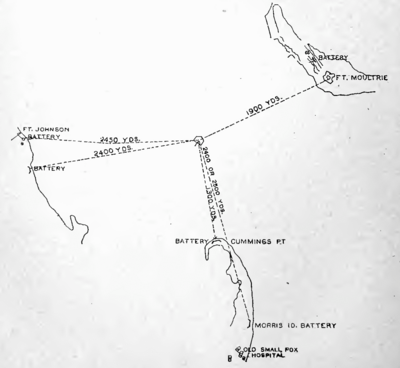
(To view this page in its Source Category, click
|
|
|
| January 28, 1861 - Captain John Foster to General Joseph Totten
|
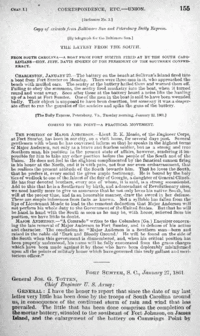 Click for full-sized scanned image 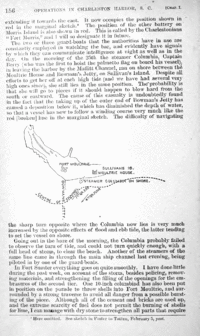 Click for full-sized scanned image 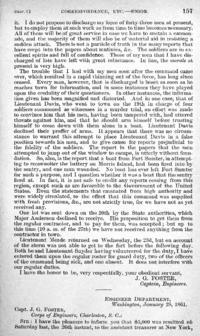 Click for full-sized scanned image Union Correspondence, etc.
FORT SUMTER, S.C., January 27, 1861.
General JOS. G. TOTTEN,
Chief Engineer U.S. Army:
GENERAL: I have the honor to report that since the date of my last letter very little has been done by the troops of South Carolina around us, in consequence of the continued storm of rain and wind that has prevailed. The little that has been done comprises the completion of the mortar battery, situated to the southeast of Fort Johnson, on James Island, and the enlargement of the battery on Cummings Point by extending it towards the east. It now occupies the position shown in red in the marginal sketch.[1] The position of the other battery on Morris Island is also shown in red. This is called by the Charlestonians "Fort Morris," and I will so designate it in future.
The two or three guard-boats that the authorities have in use are constantly employed in watching the bar, and evidently have signals by which they can communicate intelligence at night as well as in the day. On the morning of the 25th the steamer Columbia, Captain Berry [who was the first to hoist the palmetto flag on board his vessel], in leaving the harbor by the Maffitt Channel, ran on shore between the Moultrie House and Bowman's Jetty, on Sullivan's Island. Despite all efforts to get her off at each high tide [and we have had several very high ones since], she still lies in the same position. The probability is that she will go to pieces if it should happen to blow hard from the south or eastward. The cause of this casualty is undoubtedly found in the fact that the taking up of the outer end of Bowman's Jetty has caused a deposition below it, which has diminished the depth of water, so that a vessel has now to follow a winding course very much like the red [broken] line in the marginal sketch. The difficulty of navigating
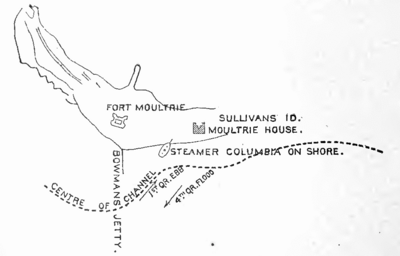
the sharp turn opposite where the Columbia now lies is very much increased by the opposite effects of flood and ebb tide, the latter tending to set the vessel on shore.
Going out in the haze of the morning, the Columbia probably failed to observe the turn of tide, and could not turn quickly enough, with a full head of steam, to clear the beach. Another of the steamers of the same line came in through the main ship channel last evening, being piloted in by one of the guard-boats.
In Fort Sumter everything goes on quite smoothly. I have done little during the past week, on account of the storm, besides policing, removing materials, and strengthening the filling of the openings for the embrasures of the second tier. One 10-inch columbiad has also been put in position on the parade to throw shells into Fort Moultrie, and surrounded by a strong traverse to avoid all danger from a possible bursting of the piece. Although all of the cement and bricks are used up, and the extreme scarcity of fuel does not permit the burning of shells for lime, I can manage with dry stone to strengthen all parts that require it. I do not propose to discharge my force of forty-three men at present, but to employ them at such work as from time to time becomes necessary. All of them will be of great service in case we have to sustain a cannonade, and the majority of them will also be of material aid in resisting a sudden attack. Terre is not a particle of truth in the many reports that have crept into the papers about mutinies, &c. The soldiers are in excellent spirits and full of confidence. Those of my men that I have discharged of late have left with great reluctance. In fine, the morale at present is very high.
The trouble that I had with my men soon after the command came over, which resulted in a rapidly thinning out of the force, has long since ceased. Every man, however, that is discharged is beset as soon as he reaches town for information, and in some instances they have played upon the credulity of their questioners. In other instances, the information given has been magnified and distorted. And in one case, that of Lieutenant Davis, who went to town on the 19th in charge of four soldiers summoned a witnesses in a murder trial, an effort was made to convince him that his men, having been tampered with, had uttered threats against him, and that he should arm himself before trusting himself to come down with them alone in a boat. Lieutenant Davis declined their proffer of arms. It appears that there was no circumstance to warrant this attempt to place Lieutenant Davis in a false position towards his men, and to give cause for reports prejudicial to the fidelity of the soldiers. The report in the papers that the men attempted to jump out of the window to escape, is utterly without foundation. So, also, is the report that a boat from Fort Sumter, in attempting to reconnoiter the battery on Morris Island, had been fired into by the sentry, and one man wounded. No boat has ever left Fort Sumter for such a purpose, and I question whether it was a boat that the sentry fired at. In fact, it is not safe to credit any reports coming from this region, except such as are favorable to the Government of the United States. Even the statements that emanated from high authority and were widely circulated, to the effect that this command was supplied with fresh provisions, &c., are not strictly true, for we have not as yet received any.
One lot as sent down on the 20th by the State authorities, which Major Anderson declined to receive. His proposition to get them from the regular contractor, and to pay for them, was accepted; but up to this time [10 a.m. of the 27th] we have not received anything from the contractor in town.
Lieutenant Meade returned on Wednesday, the 23rd, but on account of the storm was not able to get to the fort before the following day. Both he and Lieutenant Snyder having volunteered for the duty, I have entered them upon the regular roster for guard duty, two of the officers of the command being sick, and one absent. It does not interfere with our regular duties.
I have the honor to be, very respectfully, your obedient servant,
J.G. FOSTER,
Captain, Engineers.
(To view this page in its Source Category, click
|
|
|
|
|
| January 29, 1861 - General Joseph Totten to Captain John Foster
|
 Click for full-sized scanned image 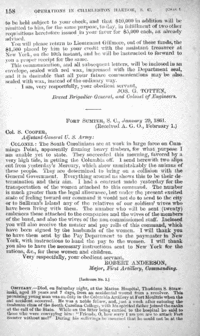 Click for full-sized scanned image Union Correspondence, etc.
ENGINEER DEPARTMENT, Washington, January 28, 1861.
Captain J.G. FOSTER,
Corps of Engineers, Charleston, S.C.:
SIR: I have the pleasure to inform you that $5,000 was remitted on Saturday last, the 26th instant, to the assistant treasurer at New York, to be held subject to your check, and that &10,000 in addition will be remitted to him, for the same purpose, to-day, in fulfillment of two other requisitions heretofore issued in your favor for $5,000 each, as already advised.
You will please return to Lieutenant Gillmore, out of these funds, the $1,500 placed by him to your credit with the assistant treasurer at New York, on the 10th instant, and he will be instructed to forward to you a proper receipt for the same.
This communication, and all subsequent letters, will be inclosed in an envelope, sealed with red wax, impressed with the Department seal, and it is desirable that all your future communications may be also sealed with wax, instead of the ordinary way.
I am, very respectfully, your obedient servant,
JOS. G. TOTTEN,
Brevet Brigadier-General, and Colonel of Engineers.
(To view this page in its Source Category, click HERE for Part 1 and HERE for Part 2)
|
|
| January 31, 1861 - Captain John Foster to General Joseph Totten
|
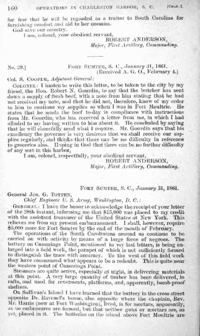 Click for full-sized scanned image 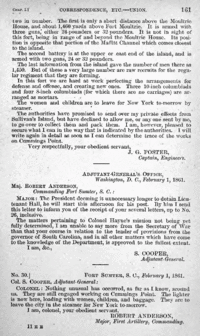 Click for full-sized scanned image Union Correspondence, etc.
FORT SUMTER, S.C., January 31, 1861.
General Jos. G. TOTTEN,
Chief Engineer U.S. Army, Washington, D.C.:
GENERAL: I have the honor to acknowledge the receipt of your letter of the 28th instant, informing me that $15,000 was placed to my credit with the assistant treasurer of the United States at New York. This relieves me from my present embarrassment. I shall, however, require $5,000 more for Fort Sumter by the end of the month of February.
The operations of the South Carolinians around us continue to be carried on with activity by means of a large force of negroes. The battery on Cummings Point, mentioned in my last letters, is being enlarged into a field work, the parapet of which is not sufficiently formed to distinguish the trace with accuracy. To the west of this field work they have commenced what appears to be a redoubt. This is quite near the western point of Cummings Point.
Steamers are quite active, especially at night, in delivering materials at this point. A very large quantity of timber has been delivered, in rafts, and used for revetments, platforms, and, apparently, bomb-proof shelters.
On Sullivan's Island I have learned that the battery in the cross street opposite Dr. Ravenel's house, also opposite where the chaplain, Rev. Mr. Harris [now at Fort Washington], lived, is for mortars, apparently, as no embrasures are formed, but that neither guns or mortars are, as yet, placed in it. The batteries on the island above Fort Moultrie are two in number. The first is only a short distance above the Moultrie House, and about 1,460 yards above Fort Moultrie. It is armed with three guns, either 24-pounders or 32-pounders. It is not in sight of this fort, being in range of and beyond the Moultrie House. Its position is opposite that portion of the Maffitt Channel which comes closest to the island.
The second battery is at the upper or east end of the island, and is armed with two guns, 24 or 32 pounders.
The last information from the island gave the number of men there as 1,450. But of these a very large number are raw recruits for the regular regiment that they are forming.
In this fort we are hard at work perfecting the arrangements for defense and offense, and creating new ones. Three 10-inch columbiads and four 8-inch columbiads [for which there are no carriages] are arranged as mortars.
The women and children are to leave for New York to-morrow by steamer.
The authorities have promised to send over my private effects from Sullivan's Island, but have declined to allow me, or any one sent by me, to go over to collect them and pack them. I am, however, pleased to secure what i can in the way that is indicated by the authorities. I will write again in detail as soon as I can determine the trace of the works on Cummings Point.
Very respectfully, your obedient servant,
J.G. FOSTER,
Captain, Engineers.
(To view this page in its Source Category, click HERE for Part 1 and HERE for Part 2)
|
|
|
| February 5, 1861 - Captain John Foster to General Joseph Totten
|
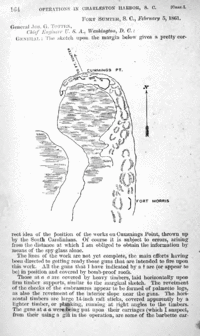 Click for full-sized scanned image  Click for full-sized scanned image Union Correspondence, etc.
FORT SUMTER, S.C., February 5, 1861.
General JOS. G. TOTTEN,
Chief Engineer U.S.A., Washington, D.C.:
GENERAL: The sketch upon the margin below gives a pretty cor-
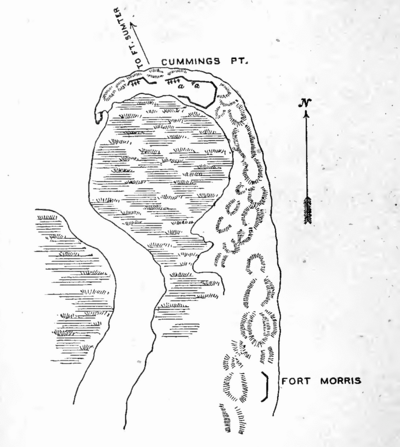
rect idea of the position of the works on Cummings Point, thrown up by the South Carolinians. Of course it is subject to errors, arising from the distance at which I am obliged to obtain the information by means of the spy-glass alone.
The lines of the work are not yet complete, the main efforts having been directed to getting ready those guns that are intended to fire upon this work. All the guns that I have indicated by a + are [or appear to be] in position and covered by bomb-proof roofs.
Those at a a are covered by heavy timbers, laid horizontally upon firm timber supports, similar to the marginal sketch. The revetment of the cheeks of the embrasures appear to be formed of palmetto logs, as also the revetment of the interior slope near the guns. The horizontal timbers are large 14-inch raft sticks, covered apparently by a lighter timber, or planking, running at right angles to the timbers. The guns at a a were being put upon their carriages [which I suspect, from their using a gin in the operation, are some of the barbette carriages from Castle Pinckney or Fort Moultrie] at the time I wrote to you this morning. Subsequently the rough opening of the embrasures was made and the revetment of the cheeks commenced.

The second bomb proof battery is built differently. The timbers on top are sloped at an angle of 45, about as in the sketch. They rest

upon two horizontal supports parallel to the direction of the battery, one higher than the other, and these are supported by stout posts, about 5 feet from each other. Upon the timbers are placed at right angles a stout planking, and upon this again another covering running up and down. This last consists of railroad iron, apparently the T rail. The work has only progressed thus far, although there is no doubt that the whole is to be covered with sand. The guns are mounted and the openings for embrasures formed.
The work is carried on quite rapidly, considering the heavy nature of the work. The idea of covering the bomb-proof with iron and giving it an inclination is no doubt derived from the Sardinian method for forming the sides of a man-of-war, so as to deflect the shot.
A large force of negroes is employed in extending the embankment of the parapet so as to connect this battery with the field work.
The guard-boats are very active at night, and some are always on the watch by day.
Inside this fort the work of preparation goes steadily on. My force is now employed in clearing the parade of the stone flagging. I am also having all the material on hand made into sand bags.
Very respectfully, your obedient servant,
J.G. FOSTER,
Captain, Engineers.
(To view this page in its Source Category, click HERE for Part 1 and HERE for Part 2)
|
|
|
|
|
| February 6, 1861 - General Joseph Totten to Captain John Foster
|
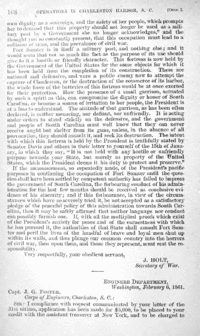 Click for full-sized scanned image  Click for full-sized scanned image Union Correspondence, etc.
ENGINEER DEPARTMENT, Washington, February 6, 1861.
Captain J.G. FOSTER,
Corps of Engineers, Charleston, S.C.:
SIR: I compliance with request communicated by your letter of the 31st ultimo, application has been made for $5,000, to be placed to your credit with the assistant treasurer at New York, and to be charged to you on account of Fort Sumter. Personal effort will be made to secure this credit without delay, and you will be promptly informed as soon as the remittance is made.
I am, very respectfully, your obedient servant,
JOS. G. TOTTEN,
Bvt. Brigadier General, and Colonel Eng.
(To view this page in its Source Category, click HERE for Part 1 and HERE for Part 2)
|
|
| February 9, 1861 - Captain Joseph Foster to General Joseph Totten
|
 Click for full-sized scanned image Union Correspondence, etc.
FORT SUMTER, S.C., February 9, 1861.
General JOS. G. TOTTEN,
Chief Engineer U.S. Army, Washington, D.C.:
GENERAL: Nothing of marked importance has transpired since the date of my last better. Your letters of the 2nd and 6th are received. The South Carolinians on Cummings Point have been occupied in perfecting the embrasures and merlons for the three guns in the field work that bear most directly upon this fort, in connecting this battery with the bomb-proof iron-covered battery by a curtain, and in completing this latter battery and extending the parapet of its flanks. On Fort Moultrie the merlons between the guns looking in this direction have been still farther raised, made roof-shaped on top, and supported more strongly by horizontal timbers, kept in place by braces extending across the embrasures at the top. I am now mining the wharf, and am also to arrange fougasses at different points on the exterior.
There does not appear to be very great activity among the South Carolinians, although the force is maintained the same.
I hear that five columbiads have arrived in the city from Richmond, and more are expected.
It is reported that the floating battery prepared in the city is a failure, the draught being greater than was expected.
Very respectfully, your obedient servant,
J.G. FOSTER,
Captain, Engineers.
(To view this page in its Source Category, click HERE)
|
|
|
| February 14, 1861 - Major Robert Anderson to Adjutant-General Samuel Cooper
|
 Click for full-sized scanned image Union Correspondence, etc.
No. 44.]
FORT SUMTER, S.C., February 14, 1861.
(Received A.G.O., February 21.)
Colonel S. COOPER, Adjutant-General:
COLONEL: I have the honor to report everything quiet, as far as we know, around us. Yesterday a few workmen were occupied apparently fitting the blinds in the embrasures of the bomb-proof battery on Cummings Point. A gun was fired yesterday in the direction of the channel from a point just eastward of the battery between the bomb-proof battery and the one which fired on the Star of the West, showing that vessels will be under fire from Morris Island after they pass the first battery.
I inclose another sketch[1] by Captain Seymour, showing the appearance of our area-battery of one 10-inch columbiad and four 8-inch sea-coast howitzers; also, a ground-plan indicating the positions and bearings of the guns in the area. These little memoranda, kindly and cheerfully prepared by the captain, give clearer views of the batteries than I could by my letters.
I am, colonel, very respectfully, your obedient servant,
ROBERT ANDERSON,
Major, First Artillery, Commanding.
- ↑ Here omitted. To appear in Atlas
(To view this page in its Source Category, click HERE)
|
|
|
| February 18, 1861 - Major Robert Anderson to Adjutant General Samuel Cooper
|
 Click for full-sized scanned image Union Correspondence, etc.
No. 48.]
FORT SUMTER, S.C., February 18, 1861.
Colonel S. COOPER, Adjutant-General:
COLONEL: I have the honor to report that we did not observe that any work was being carried on within view yesterday except by a small party of negroes, engaged in extending the covered way from the bomb-proof battery in the direction of the steamboat landing near it.
I am, colonel, very respectfully, your obedient servant,
ROBERT ANDERSON,
Major, First Artillery, Commanding.
(To view this page in its Source Category, click HERE)
|
|
|
| January 1, 1861 - Extract from Report of Operations
|
 Click for full-sized scanned image Union Correspondence, etc.
JANUARY 1, 1861.
Extract from report of operations at Fort Sumter, S.C., for the month of December, 1860.
* * * * *
The operations of the month were steadily increased from the 1st to the 26th. The casemate arches were completed; the bluestone flagging of the first tier inside of the outer traverse circles was laid on the two faces and a part of the right flank; all of the traverse stones of the first tier were reset; the granite flagging of the second tier on the right face was laid; the construction of the embrasures of the second tier was commenced, and the finishing of the east barrack was also commenced.
On the night of the 26th Major Anderson transferred his command from Fort Moultrie to Fort Sumter, and assumed command of the fort. The Engineer force broke up on the morning of the 28th, and the majority of the men left the fort. The regular work was then stopped, and all the remaining force was at once put at work mounting guns, under charge of Lieutenant Snyder, and otherwise preparing to meet and repulse any attack that the forces of the State might make upon us.
The few remaining days of the month were thus employed. A considerable quantity of material remaining on hand was of great value in making the preparations, and everything was freely used for this purpose.
J.G. FOSTER,
Captain, Engineers.
(To view this page in its Source Category, click HERE)
|
|
|
| February 21, 1861 - Major Robert Anderson to Adjutant-General Samuel Cooper
|
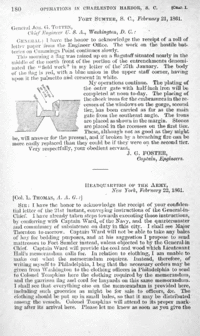 Click for full-sized scanned image Union Correspondence, etc.
FORT SUMTER, S.C., February 21, 1861.
General JOS. G. TOTTEN,
Chief Engineer U.S.A., Washington, D.C.:
GENERAL: I have the honor to acknowledge the receipt of a roll of letter paper from the Engineer Office. The work on the hostile batteries on Cummings Point continues slowly.
This morning a flag was raised up on a flagstaff situated nearly in the middle of the north front of the portion of the entrenchments denominated the "field work" in my letter of the 27th January. The body of the flag is red, with a blue union in the upper staff corner, having upon it the palmetto and crescent in white.
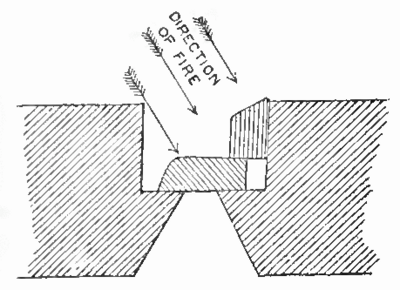
My operations continue. The plating of the outer gate with half-inch iron will be completed at noon to-day. The placing of the cheek irons for the embrasures in the recesses of the windows on the gorge, second tier, has been carried as far as the main gate from the southeast angle. The irons are placed as shown in the margin. Stones are placed in the recesses on the first tier. These, although not as good as they might be, will answer for the present, and if broken by a breaching fire can be more easily replaced than they could be if they were on the second tier.
Very respectfully, your obedient servant,
J.G. FOSTER,
Captain, Engineers.
(To view this page in its Source Category, click HERE)
|
|
|
| February 22, 1861 - Captain John Foster to General Joseph Totten
|
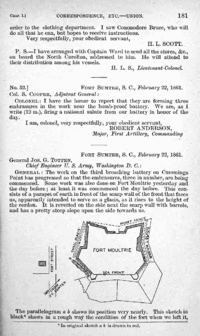 Click for full-sized scanned image 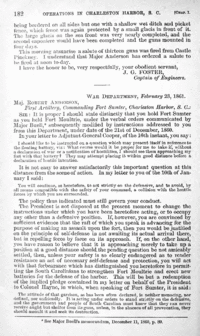 Click for full-sized scanned image Union Correspondence, etc.
FORT SUMTER, S.C., February 22, 1861.
General JOS. G. TOTTEN,
Chief Engineer U.S. Army, Washington, D.C.:
GENERAL: The work on the third breaching battery on Cummings Point has progressed so that the embrasures, three in number, are being commenced. Some work was also done on Fort Moultrie yesterday and the day before; at least it was commenced the day before. This consists of a parapet of earth in front of the scarp wall of the front that faces us, apparently intended to serve as a glaces, as it rises to the height of the cordon. It is reverted on the side next the scarp wall with barrels, and has a pretty steep slope upon the side towards us.
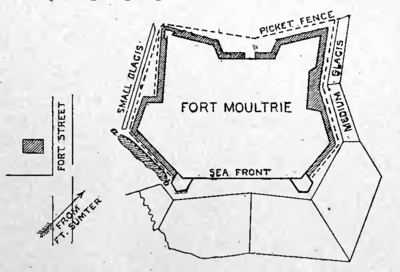
The parallelogram a b shows its position very nearly. This sketch in black[1] shows in a rough way the condition of the fort when we left it, being bordered on all sides but one with a shallow wet ditch and picket fence, which fence was again protected by a small glaces in front of it. The large glaces on the sea front was very nearly completed, and the second caponiere would have been completed and the guns mounted in four days.
This morning at sunrise a salute of thirteen guns was fired from Castle Pinckney. I understand that Major Anderson has ordered a salute to be fired at noon to-day.
I have the honor to be, very respectfully, your obedient servant,
J.G. FOSTER,
Captain of Engineers.
- ↑ In original sketch a b is drawn in red.
(To view this page in its Source Category, click HERE for Part 1 and HERE for Part 2)
|
|
|
| February 23, 1861 - Captain John Foster to General Joseph Totten
|
 Click for full-sized scanned image Union Correspondence, etc.
FORT SUMTER, S.C., February 23, 1861.
General JOS. G. TOTTEN,
Chief Engineer U.S. Army, Washington, D.C.:
GENERAL: I have the honor to report that the work upon the batteries on Cummings Point was continued last night until 12 o'clock. This increased activity seemed to have been consequent upon the visit of some official of rank, probably Governor Pickens, to these batteries in the afternoon. Guns were fired from the batteries and from Fort Moultrie in considerable numbers about the same time that the steamers [arrived] bearing the person or persons who were visiting the batteries, and were either salutes of six and seven guns each or were merely practice firing. The principal work consists of that upon the battery that I reported yesterday as being in process of construction, and upon the erection of sheds of this form-

which you perceive can be turned into bomb-proofs, covering them with earth. One of these, situated at the extreme western point of Cummings Point, is already up, and a sufficient number of rafts were towed there last night to construct two or three more.
At Fort Moultrie a force of about fifty laborers is still at work embanking the glaces in front of the face towards us. Yesterday I completed placing the cheek irons for the embrasures in the recesses of the windows on the gorge, and to-day I shall charge the fougasses on the esplanade at the gorge, and then commence clearing the parade of rubbish. I have also to take down another temporary building to obtain fuel. I have a second one yet standing, that will furnish fuel as long as the provisions will last. The weather is very pleasant and warm.
I received from the Department another roll of writing paper to-day, with two bundles of envelopes, one of large and the other of medium letter size.
I have the honor to be, very respectfully, your obedient servant,
J.G. FOSTER,
Captain, Engineers.
(To view this page in its Source Category, click HERE)
|
|
|
| February 25, 1861 - Captain John Foster to General Joseph Totten
|
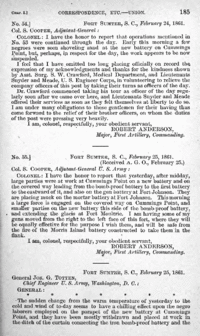 Click for full-sized scanned image 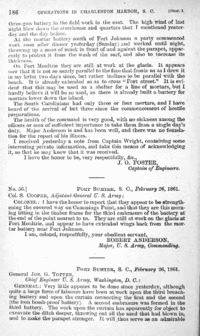 Click for full-sized scanned image Union Correspondence, etc.
FORT SUMTER, S.C., February 25, 1861.
General JOS. G. TOTTEN,
Chief Engineer U.S. Army, Washington, D. C.:
GENERAL:
* * * * *
The sudden change from the warm temperature of yesterday to the cold and wind of to-day seems to have a chilling effect upon the negro laborers employed on the parapet of the new battery at Cummings Point, and they have been mostly withdrawn and placed at work in the ditch of the curtain connecting the iron bomb-proof battery and the three-gun battery in the field work to the east. The high wind of last night blew down the storehouse and quarters that I mentioned yesterday and the day before.
At the mortar battery south of Fort Johnson a party commenced work soon after dinner yesterday [Sunday] and worked until night, throwing up a mass of muck in front of and against the parapet, apparently to protect it from the wash of the surf, and also to increase its thickness.
On Fort Moultrie they are still at work at the glaces. It appears now that it is not so nearly parallel to the face that fronts us as I drew it in my letter two days since, but rather inclines to be parallel with the beach. It is already extended so as to cross "Fort street." It is evident that this may be used as a shelter for a line of mortars, but I hardly believe it will be so used, as there is already built a battery for mortars lower down the island.
The South Carolinians had only three or four mortars, and I have heard of the arrival of but three since the commencement of hostile preparations.
The health of the command is very good, with no sickness among the officers or men of sufficient importance to take them from a single day's duty. Major Anderson is and has been well, and there was no foundation for the report of his illness.
I received yesterday a note from Captain Wright, containing some interesting private information, and take this means of acknowledging it, so that he may know that it was received.
I have the honor to be, very respectfully, &c.,
J.G. FOSTER,
Captain of Engineers.
(To view this page in its Source Category, click HERE for Part 1 and HERE for Part 2)
|
|
|
| February 26, 1861 - Captain John Foster to General Joseph Totten
|
 Click for full-sized scanned image  Click for full-sized scanned image Union Correspondence, etc.
FORT SUMTER, S.C., February 26, 1861.
General JOS. G. TOTTEN,
Chief Engineer U.S. Army, Washington, D.C.:
GENERAL: Very little appears to be done since yesterday, although quite a large force of laborers have been at work upon the third breaching battery and upon the curtain connecting the first and the second [the iron bomb-proof battery]. A second embrasure was formed in the third battery. The work upon the curtain has apparently for object to excavate the ditch deeper, throwing out all the sand that had blown in, and to make the parapet stronger. It will thus serve as an admirable position for a line of mortars. The work on the other batteries around us was hardly worthy of note yesterday.
The troops on Fort Moultrie practiced with ball to obtain the ranges of the channel and especially of that point in the main channel where it turns towards the city. The buoy on this side of the channel at this point is five eighths of a mile from us, in a direction a little south of east. The practice was excellent, all the shot striking the water nearly in the same spot; so it will be seen that the ranges are well understood now, and any vessel coming in must not expect to fare as well as the Star of the West.
The second fougasse on the gorge was charged, means for firing arranged, and the stone loaded upon it during the day yesterday.
I am to submit to-day to Major Anderson a written memorandum of the condition of the work and its capabilities to resist a bombardment, together with any additional preparations that I have to suggest. He also requires the same of Lieutenants Snyder and Meade.
I am now taking down a third temporary building to obtain fuel. there are two other buildings remaining, besides which are twelve gun carriages. I have a small quantity of new lumber reserved for emergencies. Our supplies and mails come from town as usual.
Very respectfully, your obedient servant,
J. G. FOSTER,
Captain of Engineers.
(To view this page in its Source Category, click HERE for Part 1 and HERE for Part 2)
|
|
|
| February 28, 1861 - Captain John Foster to General Joseph Totten
|
 Click for full-sized scanned image 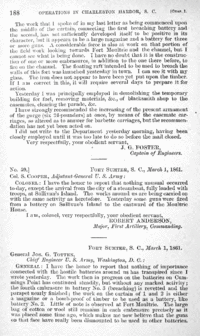 Click for full-sized scanned image Union Correspondence, etc.
FORT SUMTER, S.C., February 28, 1861.
General JOS. G. TOTTEN,
Chief Engineer U.S. Army, Washington, D.C.:
GENERAL: Yesterday and to-day being pleasant, the work upon the Cummings Point batteries has progressed well. The third battery for breaching is nearly completed, three embrasures being fully constructed and a fourth nearly so. Four 24-pounder guns were landed yesterday, evidently to arm this battery. They were upon siege carriages.
The work that I spoke of in my last letter as being commenced upon the middle of the curtain, connecting the first breaching battery and the second, has not sufficiently developed itself to be positive in its character, but it appears to be a large magazine and a battery for three or more guns. A considerable force is also at work on that portion of the field work looking towards Fort Moultrie and the channel, but I cannot see what is being done. I have no doubt that it is the construction of one or more embrasures, in addition to the one there before, to fire on the channel. The floating raft intended to be used to breath the walls of this fort was launched yesterday in town. I can see it with my glass. The iron does not appear to have been yet put upon the timber. If I am correct in this, it will require several days to prepare it for action.
Yesterday I was principally employed in demolishing the temporary building for fuel, removing materials, &c., of blacksmith shop to the casemates, clearing the parade, &c.
I have strongly recommended the increasing of the present armament of the gorge [six 24-pounders] at once, by means of the casemate carriages, so altered as to answer for barbette carriages, but the recommendation has not yet been acted on.
I did not write to the Department yesterday morning, having been closely employed until it was too late to do so before the mail closed.
Very respectfully, your obedient servant,
J.G. FOSTER,
Captain of Engineers.
(To view this page in its Source Category, click HERE for Part 1 and HERE for Part 2)
|
|
|
| March 1, 1861 - Captain John Foster to General Joseph Totten
|
 Click for full-sized scanned image 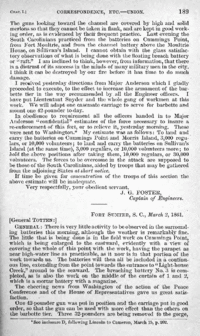 Click for full-sized scanned image Union Correspondence, etc.
FORT SUMTER, S.C., March 1, 1861.
General JOS. G. TOTTEN,
Chief Engineer U.S. Army, Washington, D.C.:
GENERAL: I have the honor to report that nothing of importance connected with the hostile batteries around us has transpired since I wrote yesterday. The work then in progress on the batteries on Cummings Point has continued steadily, but without any marked activity; the fourth embrasure in battery No. 3 [breaching] is reverted and the parapet nearly finished; the work on the curtain of 1 and 2 is either a magazine or a bomb-proof of timber to be used as a battery, like battery No. 2. Little of note is observed at Fort Moultrie. The large bag of cotton or wool still remains in each embrasure precisely as it was placed some time ago, which makes me now believe that the guns on the face have really been dismounted to be used in other batteries.
The guns looking toward the channel are covered by high and solid merlons so that they cannot be taken in flank, and are kept in good working order, as is evidenced by their frequent practice. Last evening the South Carolinians practiced from the batteries on Cummings Point, from Fort Moultrie, and from the channel battery above the Moultrie House, on Sullivan's Island. I cannot obtain with the glass satisfactory observations of what is being done with the floating breach battery or "raft." I am inclined to think, however, from information, that there is a distrust of its success in the minds of many military men in the city. I think it can be destroyed by our fire before it has time to do much damage.
I received yesterday direction from Major Anderson which I gladly proceeded to execute, to the effect to increase the armament of the barbette tier in the way recommended by all the Engineer officers. I have pour Lieutenant Snyder and the whole gang of workmen at this work. We will adapt one casemate carriage to serve for barbette and mount one 42-pounder to-day.
In obedience to requirement all the officers handed in to Major Anderson "confidential" estimates of the force necessary to insure a re-enforcement of this fort, or to relieve it, yesterday morning. These were sent to Washington.[1] My estimate was as follows: To land and carry the batteries on Cummings Point and Morris Island, 3,000 regulars, or 10,000 volunteers; to land and carry the batteries on Sullivan's Island [at the same time], 3,000 regulars, or 10,000 volunteers more; to hold the above positions after taking them, 10,000 regulars, or 30,000 volunteers. The forces to be overcome in the attack are supposed to be those the adjoining States at short notice.
If time be given for concentration of the troops of this section the above estimate will be inadequate.
Very respectfully, your obedient servant,
J.G. FOSTER,
Captain of Engineers.
(To view this page in its Source Category, click HERE for Part 1 and HERE for Part 2)
|
|
|
| March 2, 1861 - Captain John Foster to General Joseph Totten
|
 Click for full-sized scanned image 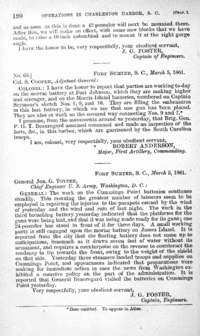 Click for full-sized scanned image Union Correspondence, etc.
FORT SUMTER, S.C., March 2, 1861.
[General TOTTEN:]
GENERAL: There is very little activity to be observed in the surrounding batteries this morning, although the weather is remarkably fine. The little that is being done is in the field work on Cummings Point, which is being enlarged to the eastward, evidently with a view of covering the whole of this point with the work, having the parapet as near high-water line as practicable, as it now is in that portion of the work towards us. The batteries will then all be included in a continuous line, extending from the point towards the entrance to "Light-house Creek," around to the seaward. The breaching battery No. 3 is completed, as is also the work on the middle of the curtain of 1 and 2, which is a mortar battery with a magazine.
The cheering news from Washington of the action of the Peace Conference and of the House of Representatives gave us great satisfaction.
One 42-pounder gun was put in position and the carriage put in good order, so that the gun can be used with more effect than the others on the barbette tier. Three 32-pounders are being removed to the gorge, and as soon as this is done a 42-pounder will next be mounted there. After this, we will make an effort, with some new blocks that we have made, to raise a 10-inch columbiad and to mount it at the right gorge angle.
I have the honor to be, very respectfully, your obedient servant,
J.G. FOSTER,
Captain of Engineers.
(To view this page in its Source Category, click HERE for Part 1 and HERE for Part 2)
|
|
|
| March 5, 1861 - Captain John Foster to General Joseph Totten
|
 Click for full-sized scanned image Union Correspondence, etc.
FORT SUMTER, S.C., March 5, 1861.
General JOS. G. TOTTEN,
Chief Engineer U. S. Army, Washington, D. C.:
GENERAL: The work on the Cummings Point batteries continues steadily. This morning the greatest number of laborers seen to be employed in repairing the injuries to the parapets caused by the wind of yesterday and the wind and rain of last night. The work in the third breaching battery yesterday indicated that the platforms for the guns were being laid, and that it was being made ready for its guns; one 24-pounder has stood in front of it for three days. A small working party is still engaged upon the mortar battery on James Island. It is reported from the city that the floating battery does not come up to anticipations, inasmuch as it draws seven feet of water without its armament, and requires a counterpoise on the reverse to counteract the tendency to tip towards the front, owing to the weight of the shield on that side. Yesterday three steamers landed troops and supplies on Cummings Point, and appearances indicated that preparations were making for immediate action in case the news from Washington exhibited a coercive policy on the part of the administration. It is reported that General Beauregard visited the batteries on Cummings Point yesterday.
Very respectfully, your obedient servant,
J.G. FOSTER,
Captain, Engineers.
(To view this page in its Source Category, click HERE)
|
|
|
| March 6, 1861 - Captain John Foster to General Joseph Totten
|
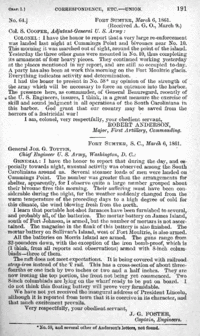 Click for full-sized scanned image Union Correspondence, etc.
FORT SUMTER, S.C., March 6, 1861.
General JOS. G. TOTTEN,
Chief Engineer U.S. Army, Washington, D.C.:
GENERAL: I have the honor to report that during the day, and especially towards night, unusual activity was observed among the South Carolinians around us. Several steamer loads of men were landed on Cummings Point. The number was greater than the arrangements for shelter, apparently, for I observe quite a large number grouped about their bivouac fires this morning. their suffering must have been considerable during the night, for the weather suddenly changed from the warm temperature of the preceding days to a high degree of cold for this climate, the wind blowing fresh from the north.
I learn that portable hot-shot furnaces have been furnished to several, and probably all, of the batteries. The mortar battery on James Island, south of Fort Johnson, is armed, but the number of mortars is not ascertained. The magazine in the flank of this battery is also finished. The mortar battery on Sullivan's Island, west of Fort Moultrie, is also armed.
All the batteries on Morris Island are armed. The guns range from 32-pounders down, with the exception of the iron bomb-proof, which is [I think, from all reports and observations] armed with 8 inch columbiads-three of them.
The raft does not meet expectations. It is being covered with railroad strap-iron instead of the T rail. This has a cross-section of about three-fourths or one inch by two inches or two and a half inches. They are now ironing the top portion, the front not being yet commenced. Two 8-inch columbiads are lying on the wharf ready to be put on board. I do not think this floating battery will prove very formidable.
We have not yet received the inaugural address of President Lincoln, although it is reported from town that it is coercive in its character, and that much excitement prevails.
Very respectfully, your obedient servant,
J.G. FOSTER,
Captain, Engineers.
(To view this page in its Source Category, click HERE)
|
|
|
| March 7, 1861 - Captain John Foster to General Joseph Totten
|
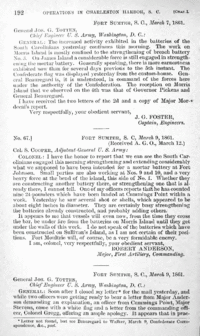 Click for full-sized scanned image Union Correspondence, etc.
FORT SUMTER, S.C., March 7, 1861.
General JOS. G. TOTTEN,
Chief Engineer U.S. Army, Washington, D.C.:
GENERAL: The increased activity exhibited in the batteries of the South Carolinians yesterday continues this morning. The work on Morris Island is mostly confined to the strengthening of breach battery No. 3. On James Island a considerable force is still engaged in strengthening the mortar battery. Generally speaking, there is more earnestness exhibited now than for several days previous to the 5th instant. The Confederate flag was displayed yesterday from the custom-house. General Beauregard is, it is understood, in command of the forces here under the authority of the Confederation. The reception on Morris Island that we observed on the 4th was that of Governor Pickens and General Beauregard.
I have received the two letters of the 2nd and a copy of Major Mordecai's report.
Very respectfully, your obedient servant,
J.G. FOSTER,
Captain, Engineers.
(To view this page in its Source Category, click HERE)
|
|
|
| March 9, 1861 - Captain John Foster to General Joseph Totten
|
 Click for full-sized scanned image 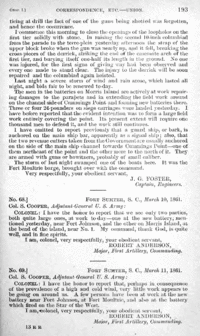 Click for full-sized scanned image Union Correspondence, etc.
FORT SUMTER, S.C., March 9, 1861.
General JOS. G. TOTTEN,
Chief Engineer U.S. Army, Washington, D.C.:
GENERAL: Soon after I closed my letter[1] for the mail yesterday, and while two officers were getting ready to bear a letter from Major Anderson demanding an explanation, an officer from Cummings Point, Major Stevens, came with a white flag and a letter from the commanding officer, Colonel Gregg, offering an ample apology. It appears that in practicing at drill the fact of one of the guns being shotted was forgotten, and hence the occurrence.
I commence this morning to close the openings of the loopholes on the first tier solidly with stone. In raising the second 10-inch columbiad from the parade to the terre-plein yesterday afternoon the strap of the upper block broke when the gun was nearly up, and it fell, breaking the cross-pieces of the derrick, striking the end of the casemate arch of the first tier, and burying itself one-half its length in the ground. No one was injured, for the first signs of giving way had been observed and every one made to stand clear. The injury to the derrick will be soon repaired and the columbiad again hoisted.
Last night a severe storm of wind and rain arose, which lasted all night, and bids fair to be renewed to-day.
The men in the batteries on Morris Island are actively at work repairing damages to the parapets and in extending the field work around on the channel side of Cummings Point and forming new batteries there. Three or four 24-pounders on siege carriages were landed yesterday. I have before reported that the evident intention was to form a large field work entirely covering the point. Its present extent will require one thousand men to defend it, and the work still continues.
I have omitted to report previously that a guard ship, or bark, is anchored on the main ship bar, apparently as a signal ship; also, that the two revenue cutters taken from the Government are usually anchored on the side of the main ship channel towards Cummings Point-one of them northeast of the point and the other more to north of it. They are armed with guns or howitzers, probably of small caliber.
The storm of last night swamped one of the boats here. It was the Fort Moultrie barge, brought over with the command.
Very respectfully, your obedient servant,
J.G. FOSTER,
Captain, Engineers.
(To view this page in its Source Category, click HERE for Part 1 and HERE for Part 2)
|
|
|
| March 11, 1861 - Captain John Foster to General Joseph Totten
|
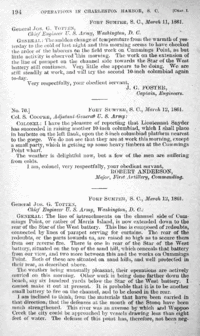 Click for full-sized scanned image Union Correspondence, etc.
FORT SUMTER, S.C., March 11, 1861.
General JOS. G. TOTTEN,
Chief Engineer U.S. Army, Washington, D.C.
GENERAL: The sudden change of temperature from the warmth of yesterday to the cold of last night and this morning seems to have checked the ardor of the laborers on the field work on Cummings Point, as but little activity is observed this morning. The work on the extension of the line of parapet on the channel side towards the Star of the West battery still continues. Very little else appears to be doing. We are still steadily at work, and will try the second 10-inch columbiad again to-day.
Very respectfully, your obedient servant,
J.G. FOSTER,
Captain, Engineers.
(To view this page in its Source Category, click HERE)
|
|
|
| March 12, 1861 - Captain John Foster to General Joseph Totten
|
 Click for full-sized scanned image 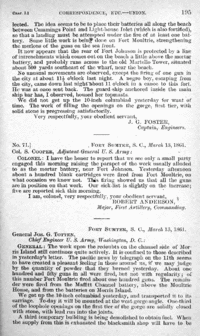 Click for full-sized scanned image Union Correspondence, etc.
FORT SUMTER, S.C., March 12, 1861.
General JOS. G. TOTTEN,
Chief Engineer U.S. Army, Washington, D.C.:
GENERAL: The line of entrenchments on the channel side of Cummings Point, or rather of Morris Island, is now extended down to the rear of the Star of the West battery. This line is composed of redoubts, connected by lines of parapet serving for curtains. The rear of the redoubts, or the parts towards us, are raised so high as to secure them from our reverse fire. There is one in rear of the Star of the West battery, situated on the top of the sand hill, which conceals that battery from our view, and two more between this and the works on Cummings Point. Both of these are situated on sand hills, and well protected in their rear, as described above.
The weather being unusually pleasant, their operations are actively carried on this morning. Other work is being done farther down the beach, say six hundred yards below the Star of the West battery. I cannot make it out at present. It is probable that it is to be another small battery to fire on the channel, and to be closed in the rear.
I am inclined to think, from the materials that have been carried in that direction, that the defenses at the mouth of the Stono have been much strengthened. This river was an avenue by which and Wappoo Creek the city could be approached by vessels drawing less than eight feet of water. The defense of this point has, therefore, not been neglected. The idea seems to be to place their batteries all along the beach between Cummings Point and Light-house Inlet [which is also fortified], so that a landing must be attempted under the fire of at least one battery. Some little work is being done on Fort Moultrie, strengthening the merlons of the guns on the sea front.
It now appears that the rear of Fort Johnson is protected by a line of entrenchments which comes out on the beach a little above the mortar battery, and probably runs across to the old Martello Tower, situated about 500 yards southeast of the wharf, near the beach.
No unusual movements are observed, except the firing of one gun in the city at about 11 1/2 o'clock last night. A negro boy, escaping from the city, came down last night about 11 o'clock in a canoe to this fort. He was at once sent back. The guard-ship anchored inside the main ship bar has, I observed, housed her topmasts.
We did not get up the 10-inch columbiad yesterday for want of time. The work of filling the openings on the gorge, first tier, with solid stone is progressing satisfactorily.
Very respectfully, your obedient servant,
J.G. FOSTER,
Captain, Engineers.
(To view this page in its Source Category, click HERE for Part 1 and HERE for Part 2)
|
|
|
| March 12, 1861 - Captain John Foster to General Joseph Totten
|
 Click for full-sized scanned image 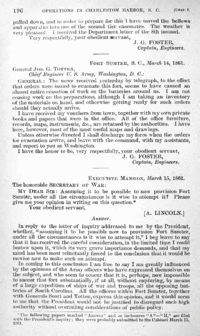 Click for full-sized scanned image Union Correspondence, etc.
FORT SUMTER, S.C., March 13, 1861.
General JOS. G. TOTTEN,
Chief Engineer U.S. Army, Washington, D.C.:
GENERAL: The work upon the redoubts on the channel side of Morris Island still continues quite actively. It is confined to those described in yesterday's letter. The pacific news by telegraph on the 11th seems to have created a pleasant feeling in those around us, if we may judge by the quantity of powder that they burned yesterday. About one hundred and fifty guns in all were fired, but not with regularity; of this number Fort Moultrie fired about one hundred guns. The remainder were fired from the Maffitt Channel battery, above the Moultrie House, and from the batteries on Morris Island.
We got up the 10-inch columbiad yesterday, and transported it to its carriage. To-day it will be mounted at the west gorge angle. One-third of the loophole openings on the first tier of the gorge are solidly closed with stone, with lead run into the joints.
A third temporary building is being demolished to obtain fuel. When the supply from this is exhaust the blacksmith shop will have to be pulled down, and in order to prepare for this I have moved the bellows and apparatus into one of the second tier casemates. The weather is very pleasant. I received the Department letter of the 8th instant.
Very respectfully, your obedient servant,
J.G. FOSTER,
Captain, Engineers.
(To view this page in its Source Category, click HERE for Part 1 and HERE for Part 2)
|
|
|
| March 15, 1861 - Captain John Foster to General Joseph Totten
|
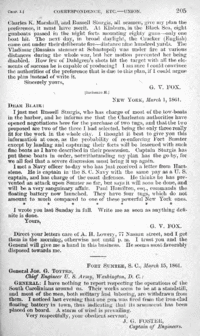 Click for full-sized scanned image Union Correspondence, etc.
FORT SUMTER, S.C., March 15, 1861.
General JOS. G. TOTTEN,
Chief Engineer U.S. Army, Washington, D.C.:
GENERAL: I have nothing to report respecting the operations of the South Carolinians around us. Their works seem to be at a standstill, and most of the men, both military and laboring, are withdrawn from them. I noticed last evening that one gun was fired from the iron-clad floating battery in town, thus indicating that its armament has been placed on board. A storm of wind is prevailing.
Very respectfully, your obedient servant,
J.G. FOSTER,
Captain of Engineers.
(To view this page in its Source Category, click HERE)
|
|
|
| March 16, 1861 - Major Robert Anderson to Adjutant-General Samuel Cooper
|
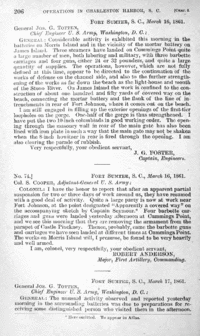 Click for full-sized scanned image Union Correspondence, etc.
No. 74.]
FORT SUMTER, S.C., March 16, 1861.
Colonel S. COOPER, Adjutant-General U.S. Army:
COLONEL: I have the honor to report that after an apparent partial suspension of tow or three days of work around us, they have resumed with a go do deal of activity. Quite a large party is now at work near Fort Johnson, at the point designated "Apparently a covered way" on the accompanying sketch by Captain Seymour.[1] Four barbette carriages and guns were landed yesterday afternoon at Cummings Point, and we see this morning that they are removing the armament from the parapet of Castle Pinckney. Thence, probably, came the barbette guns and carriages we have seen landed at different times at Cummings Point. The works on Morris Island will, I presume, be found to be very heavily and well armed.
I am, colonel, very respectfully, your obedient servant,
ROBERT ANDERSON,
Major, First Artillery, Commanding.
- ↑ Here omitted. To appear in Atlas.
(To view this page in its Source Category, click HERE)
|
|
|
| March 18, 1861 - Major Robert Anderson to Adjutant-General Samuel Cooper
|
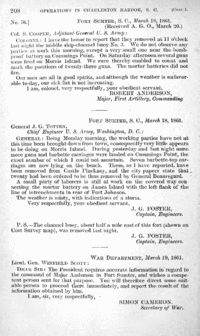 Click for full-sized scanned image Union Correspondence, etc.
No. 76.]
FORT SUMTER, S.C., March 18, 1861.
(Received A.G.O., March 20.)
Colonel S. COOPER, Adjutant-General U.S. Army:
COLONEL: I have the honor to report that they removed at 11 o'clock last night the middle ship-channel buoy Numbers 3. We do not observe any parties at work this morning, except a very small one near the bomb-proof battery on Cummings Point. On Saturday afternoon several guns were fired on Morris Island. We were thereby enabled to count and mark the positions of twenty-three guns. The mortar batteries did not fire.
Our men are all in good spirits, and although the weather is unfavorable to-day, our sick-list is not increasing.
I am, colonel, very respectfully, your obedient servant,
ROBERT ANDERSON,
Major, First Artillery, Commanding.
(To view this page in its Source Category, click HERE)
|
|
|
| March 19, 1861 - Secretary Simon Cameron to Lieutenant General Winfield Scott
|
 Click for full-sized scanned image 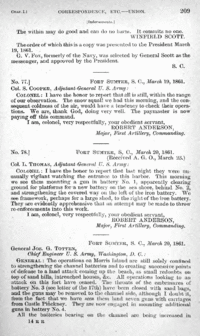 Click for full-sized scanned image Union Correspondence, etc.
WAR DEPARTMENT, March 19, 1861.
Lieut. Gen. WINFIELD SCOTT:
DEAR SIR: The President requires accurate information in regard to the command of Major Anderson in Fort Sumter, and wishes a competent person sent for that purpose. You will therefore direct some suitable person to proceed there immediately, and report the result of the information obtained by him.
I am, sir, very respectfully,
SIMON CAMERON,
Secretary of War.
[Indorsements.]
The within may do good and can do no harm. It commits no one.
WINFIELD SCOTT.
The order of which this is a copy was presented to the President March 19, 1861.
G.V. Fox, formerly of the Navy, was selected by General Scott as the messenger, and approved by the President.
(To view this page in its Source Category, click HERE for Part 1 and HERE for Part 2)
|
|
|
| Template:AOR(1)Ch1No29/215
|
|
| Template:AOR(1)Ch1No29/217
|
|
| Template:AOR(1)Ch1No29/220
|
|
| Template:AOR(1)Ch1No29/221
|
|
| Template:AOR(1)Ch1No29/226
|
|
|
|
Template:AOR(1)Ch1No29/227
|
| Template:AOR(1)Ch1No29/232
|
|
| Template:AOR(1)Ch1No29/238
|
|
| Template:AOR(1)Ch1No29/240
|
|
| Template:AOR(1)Ch1No29/241
|
|
| Template:AOR(1)Ch1No29/249
|
|
| Template:AOR(1)Ch1No29/251
|
|
| Template:AOR(1)Ch1No29/256
|
|
| Template:AOR(1)Ch1No29/267
|
|
| Template:AOR(1)Ch1No29/271
|
|
| Template:AOR(1)Ch1No29/275
|
|
| Template:AOR(1)Ch1No30/109
|
|
(US SoW) Simon Cameron
- At the outbreak of the war, Simon Cameron was the United States Secretary of War
|


















































